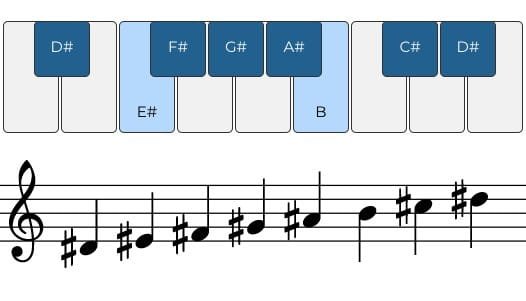The D sharp minor scale is an intriguing and rich musical scale, frequently used in various genres. Whether you’re learning piano, guitar, or any other instrument, understanding the structure, application, and emotional tone of this scale can elevate your music theory knowledge and playing ability. This guide delves into the D# minor scale, covering its construction, positions, chords, and musical context.
What is the D sharp Minor Scale?
The D# minor scale is a natural minor scale based on the note D#. It follows the standard minor scale formula, which is a specific sequence of whole and half steps: W-H-W-W-H-W-W. This translates to the following notes:
- D# – E# – F# – G# – A# – B – C#.
Key Characteristics:
- Tonic (1st note): D#
- Relative Major: F# Major (both share the same key signature of six sharps: F#, C#, G#, D#, A#, E#)
- Enharmonic Equivalent: E♭ minor (which contains the same pitches but is written differently)
The D# minor scale is mainly used in classical, romantic, and modern compositions, lending a melancholy and emotionally intense atmosphere to the music. It’s often chosen to evoke deep emotions such as sorrow or longing.
How is the D# Minor Scale Constructed?
All natural minor scales follow the same tone-semitone pattern: Whole step, Half step, Whole step, Whole step, Half step, Whole step, Whole step. For the D# minor scale, starting at D#, the sequence works as follows:
- D# to E# (Whole step)
- E# to F# (Half step)
- F# to G# (Whole step)
- G# to A# (Whole step)
- A# to B (Half step)
- B to C# (Whole step)
- C# to D# (Whole step)
When played on instruments like piano, six black keys are utilized in every octave of the scale.
D# Minor Scale on Different Instruments
Piano:
On the piano, this scale requires using a combination of both black and white keys, with most of the notes being sharp. Finger positioning plays a crucial role in navigating smoothly through the scale. The use of sharps means that you will play mostly black keys, which can be visually easier for some players.
Guitar:
For guitarists, the D# minor scale can be visualized through CAGED system positions. These scale shapes cover different parts of the fretboard and are essential for improvisation and understanding musical harmony. Each position contains the same notes but in different places on the neck, allowing guitarists to play fluently across the entire fretboard.
Chords in D# Minor Scale
The D sharp minor scale harmonizes into a set of seven chords, each built off a note of the scale. These chords are useful for creating progressions within the key of D# minor:
- D#m (i) – Tonic
- E#dim (ii°) – Supertonic diminished
- F# (III) – Mediant
- G#m (iv) – Subdominant minor
- A#m (v) – Dominant minor
- B (VI) – Submediant
- C# (VII) – Leading tone
These chords are often combined in progressions that help musicians craft emotionally driven music. A typical minor chord progression might include the i-iv-v pattern, such as D#m – G#m – A#m .
Relative and Parallel Scales
A key concept in music theory is the relationship between relative major and minor scales. The relative major of D# minor is F# major, meaning they share the same key signature but start on different tonic notes. On the other hand, the parallel major of D# minor is D# major, which starts on the same tonic note but has a different key signature and set of intervals.
Additionally, D# minor and E♭ minor are enharmonic equivalents—they contain the same pitches but are notated differently. This distinction can affect how they are used in written music, especially depending on the tonal context and the key signature of the piece.
Modes of the D sharp Minor Scale
The D# minor scale can serve as the foundation for several modes, each adding a unique color and mood to the music:
- D# Aeolian (natural minor)
- F# Ionian (major)
- G# Dorian (minor)
- A# Phrygian (minor)
- B Lydian (major)
- C# Mixolydian (major)
- E# Locrian (diminished)
These modes offer different intervals and tonalities and can be explored for creating varying musical expressions.
Application in Music
The D# minor scale has been employed by composers across various eras, especially in the Romantic period, where composers like Chopin and Tchaikovsky often used it to convey deeper emotional states. Today, it’s still a common choice in film scores, classical compositions, and even modern pop or electronic music where artists want to evoke a somber or dramatic mood.
Conclusion
Understanding the D sharp minor scale opens up new musical possibilities for composers, instrumentalists, and music students. Its distinct intervals and emotional richness make it a powerful tool in both classical and contemporary music. Whether you’re learning the scale for the first time or deepening your theoretical knowledge, the D# minor scale offers valuable insights into the nature of minor tonality and its expressive potential.


